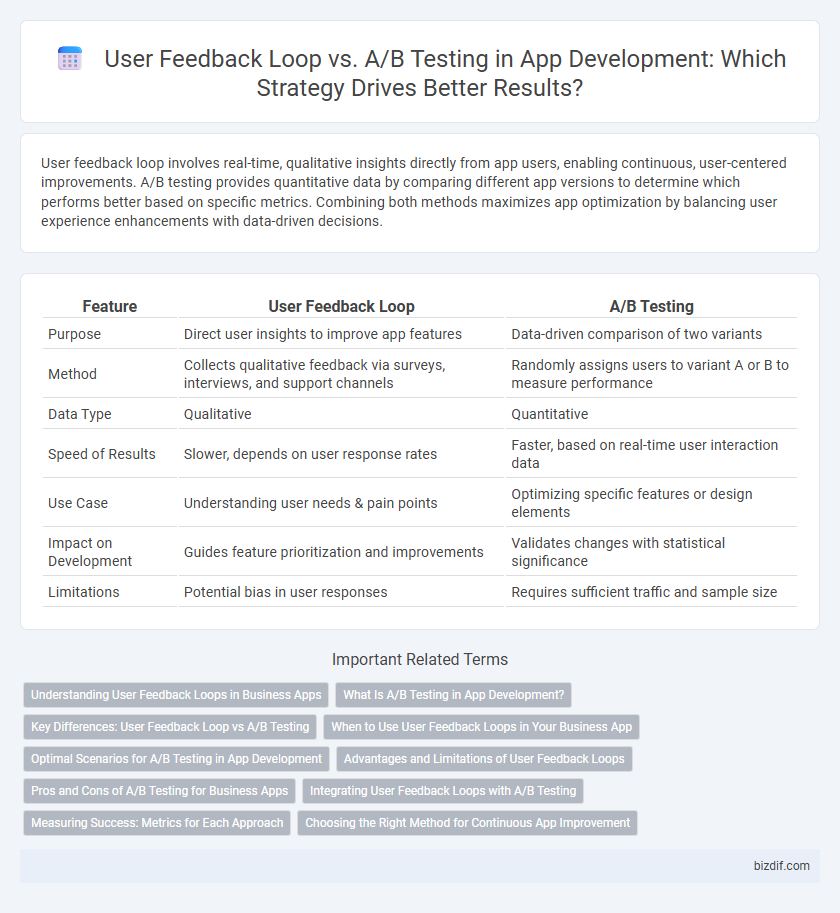User feedback loop involves real-time, qualitative insights directly from app users, enabling continuous, user-centered improvements. A/B testing provides quantitative data by comparing different app versions to determine which performs better based on specific metrics. Combining both methods maximizes app optimization by balancing user experience enhancements with data-driven decisions.
Table of Comparison
| Feature | User Feedback Loop | A/B Testing |
|---|---|---|
| Purpose | Direct user insights to improve app features | Data-driven comparison of two variants |
| Method | Collects qualitative feedback via surveys, interviews, and support channels | Randomly assigns users to variant A or B to measure performance |
| Data Type | Qualitative | Quantitative |
| Speed of Results | Slower, depends on user response rates | Faster, based on real-time user interaction data |
| Use Case | Understanding user needs & pain points | Optimizing specific features or design elements |
| Impact on Development | Guides feature prioritization and improvements | Validates changes with statistical significance |
| Limitations | Potential bias in user responses | Requires sufficient traffic and sample size |
Understanding User Feedback Loops in Business Apps
Understanding user feedback loops in business apps is essential for continuous improvement by collecting direct input from users to identify pain points and feature requests. This real-time feedback enables developers to prioritize updates that enhance user satisfaction and app performance. In comparison, A/B testing provides quantitative data by evaluating different versions, but user feedback loops offer qualitative insights crucial for strategic decision-making.
What Is A/B Testing in App Development?
A/B testing in app development involves comparing two versions of an app feature to determine which performs better based on user interactions and key performance metrics. By randomly assigning users to different variants, developers collect quantitative data that drives informed decisions. This method enables rapid optimization of design, functionality, and user experience to boost engagement and conversion rates.
Key Differences: User Feedback Loop vs A/B Testing
User Feedback Loop gathers qualitative insights directly from users through surveys, interviews, and usability tests, enabling developers to understand user needs and pain points deeply. A/B Testing involves quantitative experimentation by comparing two or more app variations to statistically measure performance differences and determine the most effective design or feature. While User Feedback Loop emphasizes iterative, user-centered improvement based on subjective input, A/B Testing relies on data-driven decisions derived from user behavior metrics and conversion rates.
When to Use User Feedback Loops in Your Business App
User feedback loops are essential for identifying pain points and gathering qualitative insights directly from app users, enabling continuous improvement based on real experiences. They are most effective during early development stages or after major feature releases, when understanding user behavior and preferences can shape product direction. Implementing user feedback loops helps prioritize feature updates and enhances customer satisfaction by aligning the app closely with user needs.
Optimal Scenarios for A/B Testing in App Development
A/B testing is optimal in app development when evaluating specific interface changes, feature rollouts, or user engagement strategies with distinct variations to identify statistically significant performance differences. It excels in scenarios requiring precise measurement of user behavior metrics like click-through rates, conversion rates, or retention, enabling data-driven decisions for incremental improvements. This method is especially effective during mid-to-late development stages when hypotheses about user preferences need validation through controlled experimentation.
Advantages and Limitations of User Feedback Loops
User feedback loops provide direct insights from real users, enabling developers to identify usability issues and prioritize feature improvements based on actual user needs. This method fosters continuous engagement and helps create a user-centric app experience, but it may be limited by biased or non-representative feedback samples and slower data collection processes. Unlike A/B testing, user feedback loops rely heavily on qualitative data, which can be subjective and harder to quantify for decision-making.
Pros and Cons of A/B Testing for Business Apps
A/B testing in business app development offers precise data-driven insights by comparing two or more app variants, enabling developers to optimize features, design, and user engagement effectively. Its main advantage lies in quantifiable results that reduce guesswork and improve decision-making based on real user behavior. However, A/B testing can be resource-intensive, potentially slow down release cycles, and may not capture qualitative user feedback critical for understanding the context behind user preferences.
Integrating User Feedback Loops with A/B Testing
Integrating user feedback loops with A/B testing enhances app development by combining qualitative insights with quantitative data, enabling more precise feature optimization. Continuous collection of user feedback helps identify pain points and preferences, which inform the creation of more targeted A/B test variants. This synergy accelerates iterative improvements, leading to higher user satisfaction and engagement rates.
Measuring Success: Metrics for Each Approach
User feedback loops rely on qualitative metrics such as user satisfaction scores, feature requests, and usability reports to measure success, providing in-depth insights into user experience and pain points. A/B testing focuses on quantitative metrics like conversion rates, click-through rates, and retention rates to statistically validate design or functionality changes. Combining these approaches offers a holistic measurement strategy, balancing subjective user insights with objective performance data for optimized app development outcomes.
Choosing the Right Method for Continuous App Improvement
User feedback loops provide direct insights from real users, enabling developers to identify pain points and prioritize feature enhancements based on authentic user experiences. A/B testing systematically compares different app variations to measure specific performance metrics like user engagement and conversion rates, allowing data-driven decisions on interface or functionality changes. Selecting the right method depends on the goal: use user feedback loops for qualitative understanding and ideation, and A/B testing for validating hypotheses and optimizing measurable outcomes.
User Feedback Loop vs A/B Testing Infographic

 bizdif.com
bizdif.com